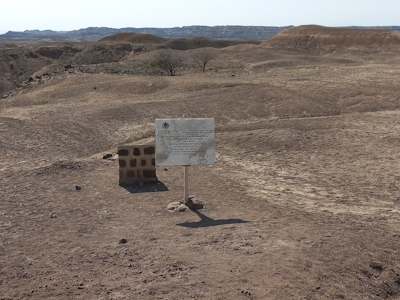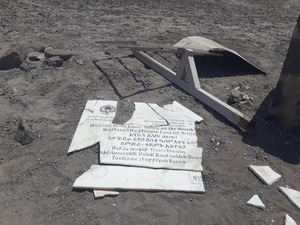Lower Valley of the Awash

The Lower Valley of the Awash is one of the most important palaeontological sites on the African continent, providing evidence of human evolution.
In this valley in Ethiopia's Afar Depression, numerous pre-human hominid and animal fossils have been found, dating back to over 4 million years ago. It is also here that in 1974 'Lucy' was found, bone fragments representing about 40% of the skeleton of an individual Australopithecus afarensis.
Community Perspective: Wojciech undertook the effort to reach this rarely visited, unspectacular place in an inhospitable area.

Map of Lower Valley of the Awash
Community Reviews
Wojciech Fedoruk

I'm pleased to announce that another blank spot on the review map on this site is being erased. Although this WHS has its reviews, they come from people who have not visited it. Still, they were useful - thanks in particular to Solivagant for the tips.
Seeing the place where Lucy's remains were discovered takes quite an effort. The permit is still necessary, but obtaining it in Semera, according to my guide, is not difficult. Getting to the excavation site is a bit more complicated. To get there, in the village of Eli Wiha, turn towards the Awash River. A local guide is absolutely necessary (they assign him with a policeman at the police checkpoint in Eli Wiha). After exactly 44 kilometers, we reach a place that is about 200 meters from the 'road' paved by 4WD cars. People live in the area, but it is extremely inhospitable. Even in January - the coldest month - it was over 30 degrees and almost no shade. Moreover, the area is not the safest, the Afars living there are a very militant nation, almost every adult man here carries a submachine gun.
The place itself is not spectacular. Contrary to what Solivagant wrote, it is not fenced in any way. There is only commemorative plaque and a billboard with WH logo. Dozens of fossilized animal bones are falling around. I don't know their exact age, but judging by their size, they certainly do not belong to the animals currently living here. Other than that, there aren't many signs of life here, although we passed a few gazelles and ostriches along the way. We also met a group of archaeologists from the USA who conduct research in the area. Even today it's not easy, I can't imagine how difficult it was 50 years ago.
To sum up – this place is only for connoisseurs. It is visited very rarely, and it is certainly NOT ‘quite “normal” to visit it as part of a 4x4 expedition into the Danakil’. Our local guide indicated that he had not been here in over a year. It is probably visited in a year by less than a hundred people from outside Ethiopia, who are not archaeologists working here. Logistically, however, it is not very difficult - you can get here from Semara in about 3.5 hours.
For those interested, I provide the exact coordinates 11.1347986N, 40.5996373E.
Tony
In 2014 I did an organised 30 day trip through Ethiopia. Our itinerary in this region was: Kombolcha - Awash and the next day from Awash to Harar.
From Kombolcha (or Dessie) you travel around 4-6 hours on a gravel road before reaching the main Djibouti road. This is a good asphalt road. Our guid mentioned that in this area Lucy was found, but it is almost impossible to visit this site itself as there is no infrastructure between Kombolcha and Awash. You start very early and arrive at dark in Awash.
Solivagant
Els’s count of WHS reviews implicitly presumes that anyone reviewing a site will have been there! In the case of the “Lower Valley of the Awash” this is unfortunately not so in my case. Nevertheless during our Dec 2007 visit to Ethiopia I questioned our local guide (who had visited the site on numerous occasions) quite closely about it. The information I gathered might be of interest to anyone thinking of visiting, both to help them decide whether it would be worth it, and to help them with the logistics if they do go!
As the location where the remains of the early hominid nicknamed “Lucy” were discovered, the site certainly has a world-wide significance. It is called “Hadar” and is situated south of the Danakil depression around 2-3 hours dirt road drive north of the Awash- Djibouti road near the new regional capital of Semera. Apparently it is quite “normal” to visit it as part of a 4x4 expedition into the Danakil or as a “diversion” on the way back from Lalibela to Addis.
Permission is needed from the Afar Regional State Tourism Commission in Semera. Entrance is paid to them at 50 birr per foreigner (c US$5) and a guide must be taken (cost not known). We were told that a “scout” is only needed as well if you are going on into the Danakil. This area is tribal and the sensibilities of the locals have to be assuaged by local involvement in the form of a guide at least.
And what will you see? Apparently the site is surrounded by a fence and is marked by the UNESCO logo. Universities are still digging in the region but I didn’t get any indication that they would welcome kibbitzers! You will see a number of “depressions” where digs have previously taken place and the location where “Lucy” was found is marked. And that seemed to be about it (but this appears to be more than can be seen in the Lower Valley of the Omo – see my review)!
In constructing our route around Ethiopia for Dec 2007 I did consider visiting this site and “bagging” another WHS. We however were going no closer than Awash on the road to another WHS at Harer. The diversion would have taken c2 extra days and 800 kms return. Just to see a few holes in the ground and a UNESCO sign? Even my desire to tick off WHS baulked at this! I would have done it if we had been taking in the Danakil or possibly even as a shorter extension on the way back from Lalibela! But you will have to make up your own mind how important seeing this site is to you!
Incidentally, the remains of “Lucy”, which are normally kept in a museum in Addis (though I think that only a copy is usually on view?), are currently, and very controversially, on tour in the USA for several years. Our guide told us that the tour would earn his country $25 million – “Enough for 3 hospitals”. Apparently the Smithsonian (and other museums) have refused to get involved on the basis that the bones are too fragile to move.
On an associated matter. This site was inscribed in 1980, together with another Ethiopian early hominid site “Lower Valley of the Omo”. That year Ethiopia had another 2 sites accepted and 6 deferred (more recent rules prevent such multiple proposals). These latter included yet another early hominid site at Melka Kunture. This site (near the WHS of Tiya) has recently been the recipient of a rather fine museum built with aid from various European institutions. The museum covers both the specific site as well as placing all the Rift Valley hominid sites in context, both in African and worldwide terms. Its excellent Museum Web site provides information on a whole range of African early hominid topics including Lower Awash (Hadar) and Omo - it is well worth perusing. It also refers to the fact that Ethiopia is trying to get Melka Kunture inscribed in its own right. However, despite its deferral in 1980, it is not currently on Ethiopia's Tentative List and cannot be proposed whilst that remains the case. However, if it does happen, it would seem so much better to link the Omo and Awash as well as Olduvai (and possibly other sites such as Turkana too) into a single multi-national site "Early Hominid sites of the African Rift Valley" - along the lines of the Museum display. But UNESCO seems to be somewhat muddled on this whole subject. The 1997 ICOMOS review of Potential Fossil Hominid sites
(Gamble and Stringer) states that Olduvai is already inscribed - well it is NOT since Ngorongoro is ONLY inscribed on "Natural" criteria and its hominid remains are not therefore officially covered. It also says that Hadar should be inscribed when it already was!!
Community Rating
Site Info
- Full Name
- Lower Valley of the Awash
- Unesco ID
- 10
- Country
- Ethiopia
- Inscribed
- 1980
- Type
- Cultural
- Criteria
-
2 3 4
- Categories
- Paleontology - Human evolution
- Link
- By ID
Site History
1980 Inscribed
1979 Deferred
Bureau meeting - info requested in 78 still not in place
1978 Deferred
Bureau meeting - info requested
Site Links
Unesco Website
Related
Connections
The site has 10 connections
Ecology
History
Science and Technology
Timeline
Trivia
Visiting conditions
WHS Names
World Heritage Process
Visitors
19 Community Members have visited.
